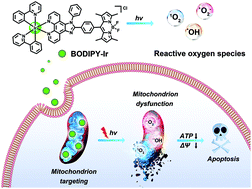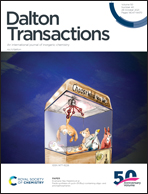A mitochondrion-targeted BODIPY-Ir(iii) conjugate as a photoinduced ROS generator for the oxidative destruction of triple-negative breast cancer cells†
Abstract
Photodynamic therapy (PDT) provides an alternative option to root out localized triple-negative breast cancer (TNBC) and has been experiencing a surge of research interest over recent years. In this study, we put forward a paradigm of designing novel transition metal-based PSs with the following characteristics: favorable cell-permeability, significant light-harvesting ability and prominent ROS yield. A novel BODIPY-Ir(III) conjugate has been designed as a photoinduced ROS (1O2, ˙OH and ˙O2−) generator. BODIPY-Ir is highly photoactive in subduing cancer cells in the PDT regimen with PI values ranging from 172 to 519 and EC50 in the nanomolar regime. Among various cancerous cell lines, TNBC was especially sensitive to BODIPY-Ir-mediated PDT, with a stunning EC50 value of 4.32 nM (PI = 519) under a moderate flux of visible-light irradiation (500 nm, 10.5 mW cm−2). BODIPY-Ir mainly accumulates in mitochondria and induces cell apoptosis under irradiation. Furthermore, the nanomolar antiproliferative activity of BODIPY-Ir is retained under hypoxia (2.5% O2). This work sheds light on instilling the O2-independent type I mechanism and conferring a red-shift absorption to metal-based PSs which fundamentally facilitate the clinical translation of PSs.



 Please wait while we load your content...
Please wait while we load your content...